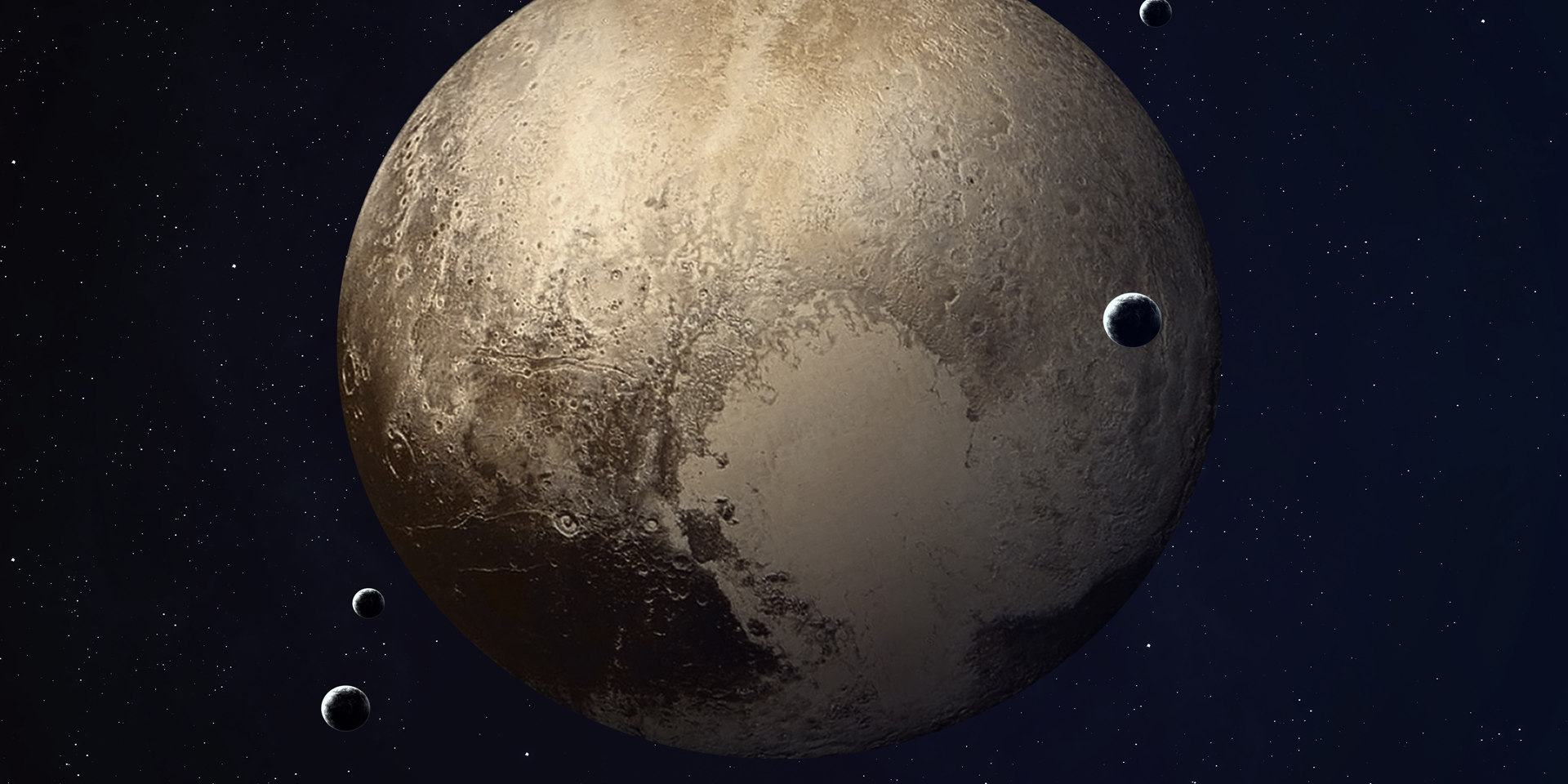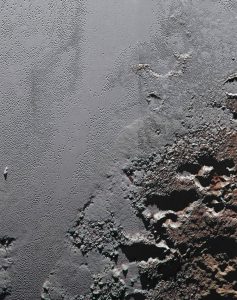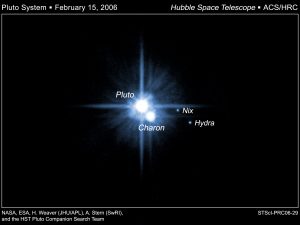
ABY.B | Pluto and Trans-Neptunian Objects
What isn’t a planet (anymore), was named by an 11-year-old girl, is smaller than Earth’s moon, has mountains higher than the Rockies and a heart-shaped glacier that is bigger than Texas, and has red snow?
That would be Pluto, the oddest, coolest object in our solar system (so far–who knows what else we’ll discover!) How do we have all this amazing information about Pluto? As with so many of our recent discoveries about space, we can thank the New Horizons Probe. Launched in 2006, New Horizons got to Pluto in 2015, where it recorded data for over a year.
 Though New Horizons did provide us with a wealth of new data about Pluto, we already knew many of the basic facts. Pluto’s existence was first predicted in 1905. American astronomer Percival Lowell noticed that the orbits of Neptune and Uranus were being affected by something. He theorized that there must be a planetary body with strong enough gravity to affect the other planets. Sadly, Lowell died before Pluto’s official discovery in 1930 by astronomer Clyde W. Tombaugh. The name Pluto, Roman god of the underworld, was suggested by Venetia Burney of Oxford, England. Her grandfather sent the name to the Lowell Observatory, where it was officially selected, and Pluto joined the roster of the other eight planets in our solar system. In addition to her eternal fame, Venetia received five pounds (£5) as a reward. Today, that amount would be worth more than $400!
Though New Horizons did provide us with a wealth of new data about Pluto, we already knew many of the basic facts. Pluto’s existence was first predicted in 1905. American astronomer Percival Lowell noticed that the orbits of Neptune and Uranus were being affected by something. He theorized that there must be a planetary body with strong enough gravity to affect the other planets. Sadly, Lowell died before Pluto’s official discovery in 1930 by astronomer Clyde W. Tombaugh. The name Pluto, Roman god of the underworld, was suggested by Venetia Burney of Oxford, England. Her grandfather sent the name to the Lowell Observatory, where it was officially selected, and Pluto joined the roster of the other eight planets in our solar system. In addition to her eternal fame, Venetia received five pounds (£5) as a reward. Today, that amount would be worth more than $400!
Fast forward about 75 years. In 2006, the International Astronomical Union developed three criteria for planets:
- in orbit around the sun (check)
- a nearly round shape (check)
- “cleared the neighborhood” around its orbit (buzzer, sad trombone, cries of outrage from the general population).
“Cleared the neighborhood” means that the object is gravitationally dominant in its orbit and it clears away other objects in its orbital path. There have been calls to amend this definition so that Pluto would again have full planet status (asteroids and comets butt into planetary orbits very often), but none of them have been accepted, so Pluto was originally designated as a dwarf planet, but has also been classified as a “plutoid”. What’s the stuff around Pluto or in its orbit that caused the disqualification? Those would be “plutinos.” Yes, really. A plutino is an icy celestial body that rotates twice in the same time it takes Neptune to rotate three times.
 Despite the new classification, the actual details of Pluto’s existence haven’t changed. Pluto is about 1430 miles in diameter. That means that not only is it smaller than Earth, it’s smaller than our moon! Even Mercury, smallest of the official planets, is twice as large as Pluto. Pluto’s surface temperature is between -378 degrees and -396 degrees. A day there lasts about six Earth days, and a year is about 248 Earth years.
Despite the new classification, the actual details of Pluto’s existence haven’t changed. Pluto is about 1430 miles in diameter. That means that not only is it smaller than Earth, it’s smaller than our moon! Even Mercury, smallest of the official planets, is twice as large as Pluto. Pluto’s surface temperature is between -378 degrees and -396 degrees. A day there lasts about six Earth days, and a year is about 248 Earth years.
Pluto’s orbit keeps it about 3.6 billion miles away from the Sun on average, making it the closest object in the Kuiper Belt (more on that in the next lesson). What’s more, Pluto’s orbit is elliptical instead of circular, and is tilted compared to that of the other planets.
Pluto has five moons, and when they were named, scientists stuck with the “underworld” theme. The main moon is  Charon, the boatman who ferries dead souls across the river Styx (another moon) in Greek mythology. There’s also Nix, mother of Charon and goddess of darkness and night in her own right. Hydra is the nine-headed serpent and Kerberos is a three headed dog–both had the job of guarding the entrance to the underworld. And it goes beyond the moons. A large dark area near Pluto’s south pole has been named Cthulhu, a monster from the literature of HP Lovecraft, and an area near Charon’s north pole is called Mordor, the black land from Tolkien’s Lord of the Rings series.
Charon, the boatman who ferries dead souls across the river Styx (another moon) in Greek mythology. There’s also Nix, mother of Charon and goddess of darkness and night in her own right. Hydra is the nine-headed serpent and Kerberos is a three headed dog–both had the job of guarding the entrance to the underworld. And it goes beyond the moons. A large dark area near Pluto’s south pole has been named Cthulhu, a monster from the literature of HP Lovecraft, and an area near Charon’s north pole is called Mordor, the black land from Tolkien’s Lord of the Rings series.
The moons of Pluto are intriguing too – in fact, Charon is about half as big as Pluto, and only about 12,000 miles away. Since Charon and Pluto seem to orbit a point in space between them, scientists consider them a double dwarf planet, or binary system.
So what’s the deal with the red snow? Methane, carbon dioxide, and nitrogen ice cover much of Pluto’s surface. The bright red “snow” seen on some of Pluto’s mountain peaks could be methane from the atmosphere that has condensed as ice. But hold onto your parkas–there won’t be skiing on Pluto any time soon!
Now let’s take a look at the rest of the Kuiper Belt.
Curriculum Reference Links
- Earth and Space / Building Blocks/ 1: Students should be able to describe the relationships between various celestial objects including moons, asteroids, comets, planets, stars, solar systems, galaxies and space.
- Earth and Space / Building Blocks/ 3: Students should be able to interpret data to compare the Earth with other planets and moons in the solar system, with respect to properties including mass, gravity, size, and composition.




